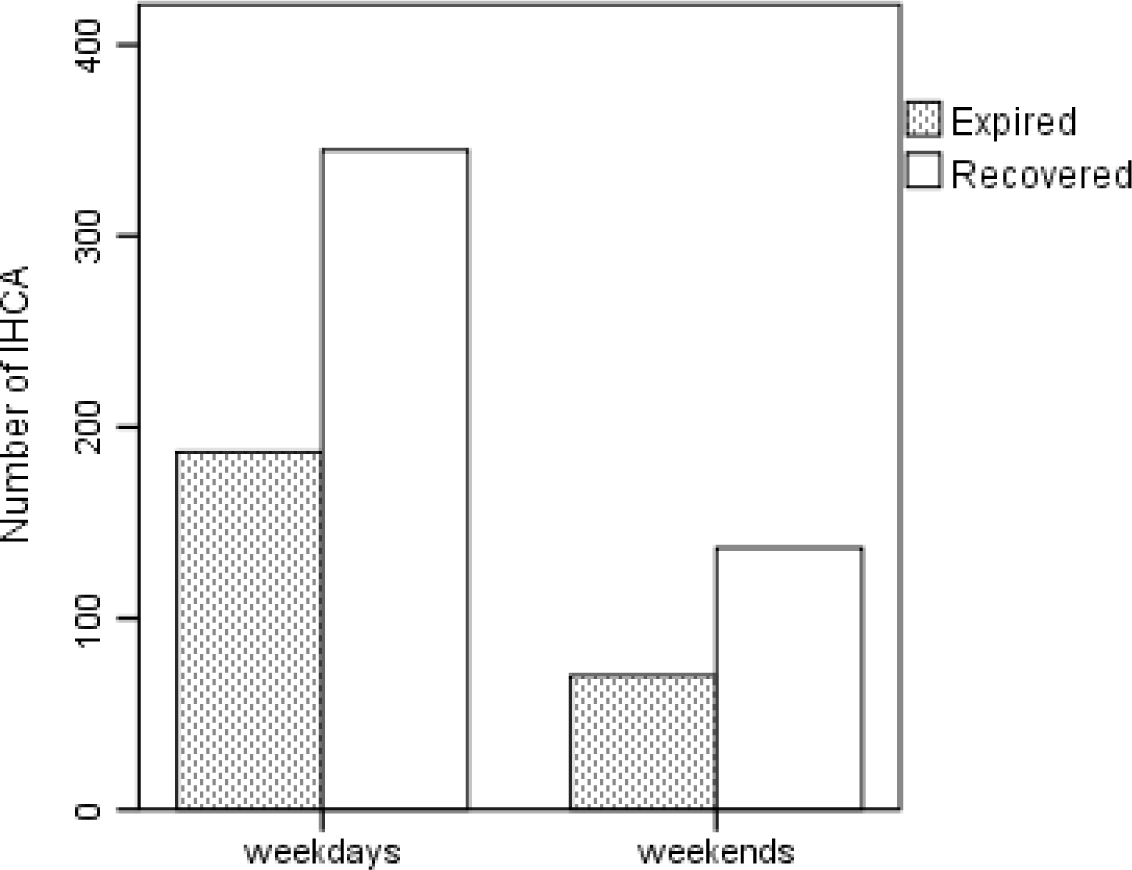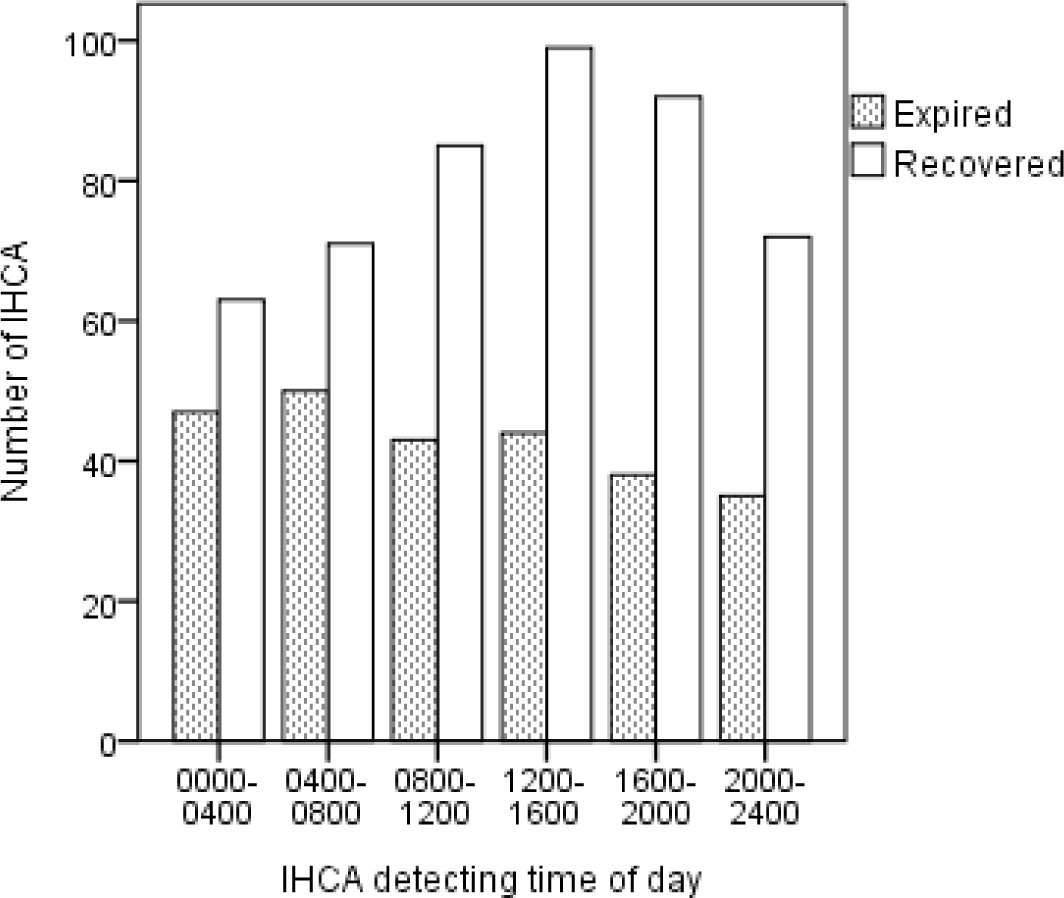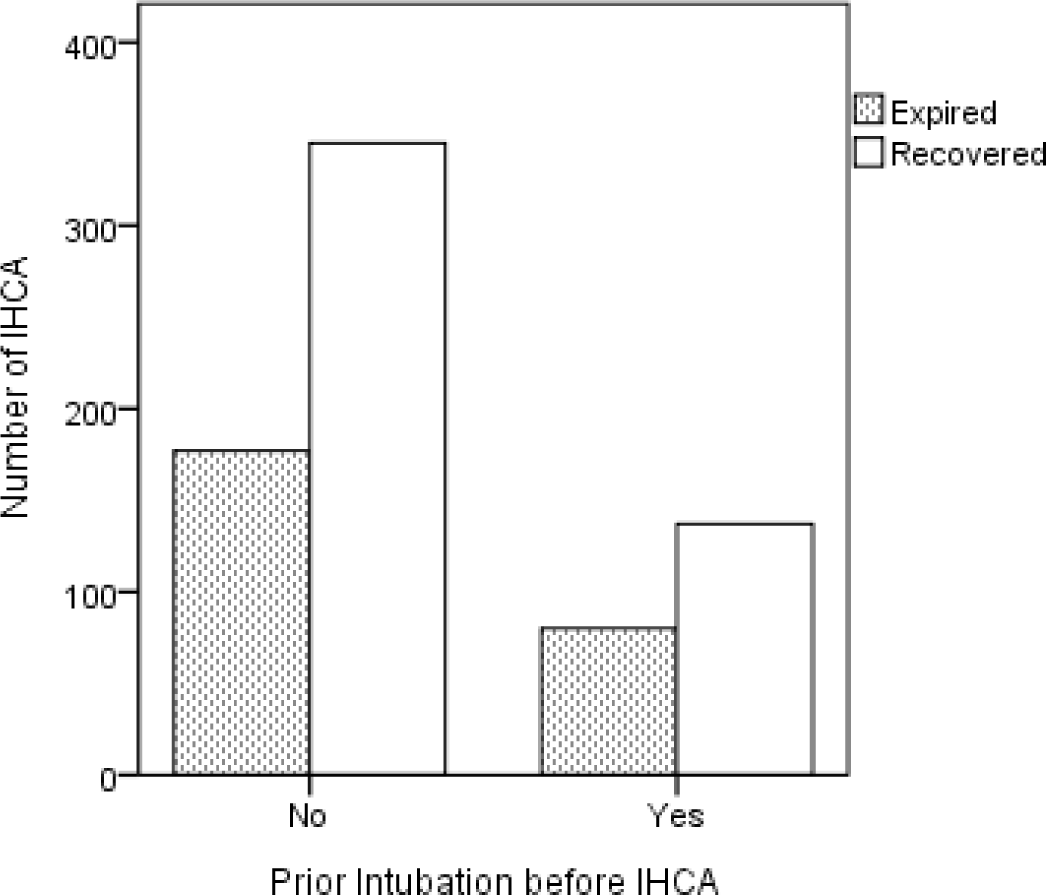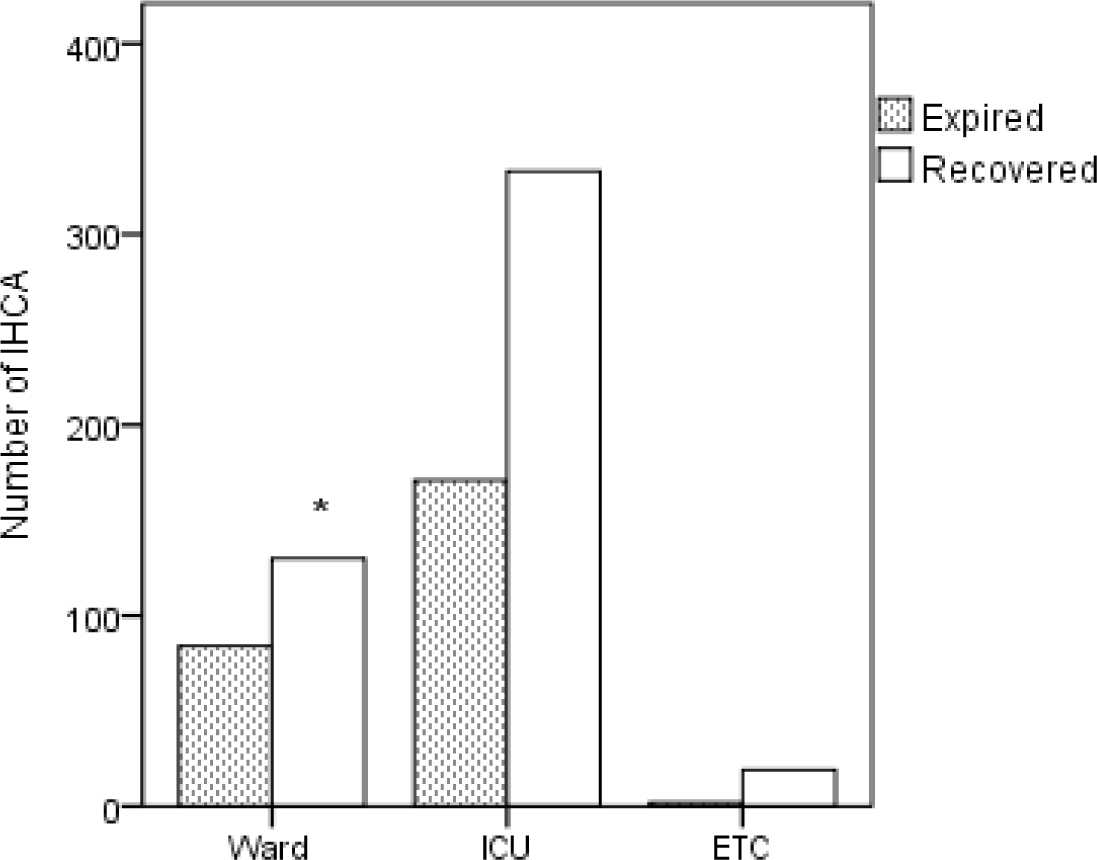INTRODUCTION
Cardiac arrest is a leading cause of mortality, with a survival rate of only 12% [1]. In the United States, cardiac arrests were significantly more likely to occur on Saturdays than on other days [1]. Further, patients experiencing out-of-hospital cardiac arrest (OOHCA) during the weekend were 20% less likely to survive hospital admission than those experiencing OOHCA on a weekday. The reduced survival rates for weekends may be due to a decrease in staffing on weekends. In-hospital cardiac arrest (IHCA) is common and often fatal [2]. Despite significant attention to resuscitation in hospitals, national data on trends in the incidence and survival rates of IHCA are limited [3].
Considering that the survival rates for OOHCA are lower during the weekend than on weekdays, we retrospectively reviewed IHCA records to see if this trend was also observed for IHCA. We also investigated factors related to IHCA that could help in improving cardio-pulmonary-cerebral resuscitation (CPCR) guidelines and monitoring patients at risk of IHCA.
MATERIALS AND METHODS
We retrospectively reviewed electronic medical records to identify cases of IHCA based on anonymous patient identification numbers. To determine factors that may influence the occurrence and survival rates of IHCA, we analyzed data from 3 years for the following items, regardless of the cause of hospitalization: clinical department, unit (ward or intensive care unit [ICU]), day of admission (weekday or weekend), time of admission, time from IHCA to CPCR code announcement, time from IHCA to CPCR initiation, pre-IHCA intubation status, number of intubation attempts after IHCA, and CPCR outcome (death or survival).
RESULTS
A total of 861 IHCAs occurred at CBNUH between 2018 and 2020 (327, 277, and 257 admissions in 2018, 2019, and 2020, respectively). Of these, 739 IHCA cases were included in the analysis of clinical outcome (recovery or survival), because the clinical outcomes of 122 IHCA cases were not mentioned in the medical records. All 861 IHCA cases were included in the descriptive analysis of demographic data; these data included recurrent IHCA cases, as some patients experienced IHCA 2–5 times.
The mean age of the participants was 68.5 years, with a male predominance (65.0% men). The survival rate was 65.2%, although this was not the rate of survival to hospital discharge. Almost 72% of the IHCAs occurred on weekdays. However, the survival rate did not differ between weekdays and weekends (64.8% vs. 66.1%, chi-square test, Fig. 1). The time of day at which IHCA occurred (Fig. 2) and pre-IHCA intubation status (Fig. 3) did not affect survival. The patients admitted to wards were less likely to survive than those admitted to ICUs (60.0% vs. 66.0%, p<0.05, Fig. 4). The time from IHCA to CPCR code announcement and time from IHCA to CPCR initiation, pre-IHCA intubation status, clinical department, and number of intubation attempts after IHCA were not significant.




DISCUSSION
In this study, patients who experienced IHCA on weekends (66.1%) had slightly higher survival rate than those who experienced IHCA on weekdays (64.8%), although this was not statistically significant. This differs from the results of a previous study that reported lower survival on weekends than on weekdays [4]. Further studies should identify factors, other than the considerably fewer cardiac arrests on weekends than on weekdays (almost 72% of IHCAs occurred on a weekday), that can influence this finding; this will help reduce the differences in survival rate between weekdays and weekends and improve the survival rate.
This study included 861 cases of IHCA. Patients with IHCA are reportedly older, are more often women, and more frequently have witnessed ventricular fibrillation (VF) than patients with OHCA [4]. However, this study did not compare OHCA and IHCA data or evaluate the type of rhythm, such as (VF, ventricular tachycardia [VT], or cardiac standstill, and witness status, which can be valuable in predicting the patients' prognosis and guiding treatments such as early defibrillation.
The incidence of IHCA is seldom reported in the literature. It ranges from 1 to 5 events per 1,000 hospital admissions [5–7] or 0.175 events/bed annually [8]. These rates are consistent with our results of 1.2–1.3 IHCAs per 1,000 hospital admissions per year at CBNUH in 2018–2020.
Reported rates of survival to hospital discharge in patients with cardiac arrest vary greatly, from 0% to 42%, with most reports mentioning rates between 15% and 20% [8–12]. This study evaluated the post-resuscitation clinical outcome in terms of death or survival and did not include following the patients who survived up to discharge. In this study, of 739 IHCA events, 65.2% ended in survival, although this was not the rate of survival to hospital discharge, and the rate was higher than that in a previous study [13]. Various pre–cardiac arrest patient comorbidities have been reported as probable prognostic factors. The Pre-Arrest Morbidity Score [14] and Prognosis After Resuscitation Score [15] have been proposed as instruments for predicting failure to survive after IHCA; however, they have not been prospectively validated. Despite this, these comorbidities are highly related to poor prognosis or survival [16–18]. The patients in this study had similar major comorbidities as those in previous studies, including chronic heart diseases, chronic pulmonary diseases, cerebrovascular diseases, sepsis, malignant neoplasm, and end-stage renal disease. Intra-arrest factors, such as VF or VT as the first recorded rhythm, are also thought to affect the post-resuscitation prognosis of patients with cardiac arrest. Prompt initiation of CPCR or defibrillation after the detection of cardiac arrest is reasonably and strongly associated with good patient outcomes [5, 8, 9, 12, 19–21]. This is important because patients with IHCA more frequently have VF than those with OHCA [3], and only 25%–35% of patients with IHCA have VF or VT [7, 8, 10, 22, 23].
Approximately one in eight patients had another IHCA subsequently, and the patients who only experienced one IHCA had better resuscitation outcomes than those who experienced recurrent IHCA [24]. These results provide clinicians managing patients with recurrent IHCA with crucial prognostic information and help them make decisions regarding resuscitation and end-of-life care. In this study, irrespective of survival, DNR (do not resuscitate) and patient care withdrawal rates were the lowest for patients with recurrent IHCA. Our study also included some patients with recurrent IHCA (2–5 recurrences). Because of the inaccuracy of the data, we could not conduct a precise analysis of the survival rate of patients with recurrent IHCA, but we presume that their outcomes were worse than those of patients without recurrent IHCA.
CONCLUSION
In this study, the survival rates of patients with IHCA did not differ between the weekend and weekdays. Nevertheless, meticulous patient care and monitoring in terms of intr- or extrapulmonary oxygen therapy is needed, as is the promotion of CPCR equipment availability and quick rescuer responses for patients with IHCA. Based on the rates of survival after IHCA or OHCA, patients with moderate or severe comorbidity burdens have a low chance of surviving. However, the active and early initiation of CPCR and using a team-based approach improved IHCA survival in our hospital. Prospective trials are needed to establish the efficacy of standardized CPCR training programs in improving patient survival after cardiac arrest.







